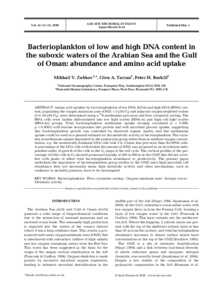Document
Bacterioplankton of low and high DNA content in the suboxic waters of the Arabian Sea and the Gulf of Oman : abundance and amino acid uptake.
Identifier
DOI: 10.3354/ame043023
Source
Aquatic Microbial Ecology. v. 43, 1, p. 23-32
Contributors
Tarran, Glen A., Author
Burkill, Peter H., Author
Country
Germany.
City
Oldendorf/Luhe
Publisher
Inter-Research.
Gregorian
2006-05-03
Language
English
English abstract
Amino acid uptakes by bacterioplankton of low DNA (LNA) and high DNA (HNA) content, populating the oxygen minimum zone (OMZ: 5 μM O2) and adjacent oxygen-depleted waters (5 to 50 μM O2), were determined using a 35S-methionine precursor and flow cytometric sorting. The HNA cells were further differentiated into low light scatter (HNA-ls) and high cell light scatter (HNA-hs) groups. Total bacterioplankton methionine uptake strongly correlated (r > 0.998, p 0.0001) with leucine incorporation into protein and with microbial glucose uptake, suggesting that bacterioplankton growth was controlled by dissolved organic matter, and that methionine uptake could be used as a general estimate for the metabolic activity of bacterioplankton. The variation in methionine uptake depended on the prokaryote group rather than on ambient oxygen concentration, e.g. the numerically dominant LNA cells took 3 to 5 times less precursor than the HNA cells. A percentage of the LNA cells with double the amount of DNA was proposed as an incubation-independent index of growth of the cells in the G2 stage of the cell cycle. The vertical profiles of the percentage of LNA cells in G2 showed pronounced peaks at 300 to 600 m in the OMZ that did not correlate with peaks of either total bacterioplankton abundance or productivity. The present paper underlines the importance of bacterioplankton group studies in the OMZ since high microbial cell abundance does not necessarily mean high metabolic activity and other mechanisms, such as resilience to mortality pressure, have to be investigated.
ISSN
0948-3055
Category
Journal articles

